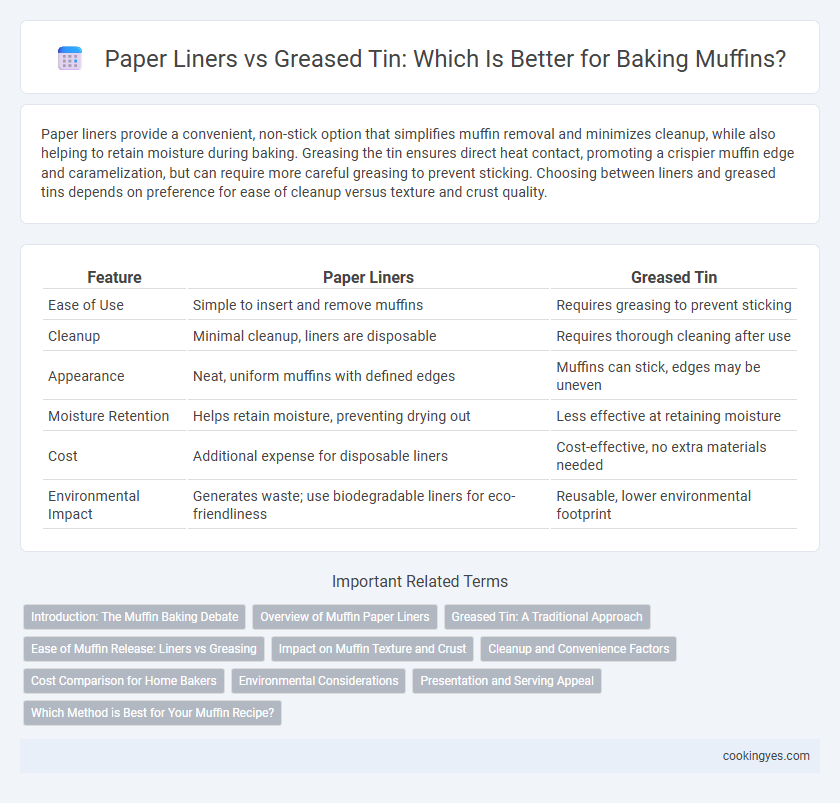Paper liners provide a convenient, non-stick option that simplifies muffin removal and minimizes cleanup, while also helping to retain moisture during baking. Greasing the tin ensures direct heat contact, promoting a crispier muffin edge and caramelization, but can require more careful greasing to prevent sticking. Choosing between liners and greased tins depends on preference for ease of cleanup versus texture and crust quality.
Table of Comparison
| Feature | Paper Liners | Greased Tin |
|---|---|---|
| Ease of Use | Simple to insert and remove muffins | Requires greasing to prevent sticking |
| Cleanup | Minimal cleanup, liners are disposable | Requires thorough cleaning after use |
| Appearance | Neat, uniform muffins with defined edges | Muffins can stick, edges may be uneven |
| Moisture Retention | Helps retain moisture, preventing drying out | Less effective at retaining moisture |
| Cost | Additional expense for disposable liners | Cost-effective, no extra materials needed |
| Environmental Impact | Generates waste; use biodegradable liners for eco-friendliness | Reusable, lower environmental footprint |
Introduction: The Muffin Baking Debate
Paper liners provide a convenient, mess-free option that preserves muffin shape and enhances presentation, while greased tins offer a traditional method that can yield crispier edges and a more uniform browning. Choosing between paper liners and greasing tins impacts texture, ease of removal, and cleanup time in muffin baking. Home bakers often weigh factors such as moisture retention and environmental impact when deciding the best approach.
Overview of Muffin Paper Liners
Muffin paper liners provide a convenient, non-stick solution that simplifies cleanup and maintains muffin shape during baking. Made from greaseproof or parchment paper, they help retain moisture and enhance presentation, making muffins easier to handle and serve. Unlike greased tins, paper liners prevent direct contact with baking pans, reducing the risk of uneven cooking or batter sticking.
Greased Tin: A Traditional Approach
Greased tins provide a traditional and reliable method for muffin baking, ensuring a golden, crisp crust and easy release without sticking. Unlike paper liners, greasing allows direct contact with the metal, promoting even heat distribution and a slightly caramelized exterior. This method is preferred by bakers seeking a classic texture and the flexibility to customize muffin appearance without the barrier of liners.
Ease of Muffin Release: Liners vs Greasing
Paper liners provide a clean, non-stick surface that ensures effortless muffin release without residue, preserving the muffin's shape and texture. Greased tins offer a traditional method but may cause uneven sticking or greasy spots, requiring careful application and cooling for optimal release. Choosing paper liners enhances convenience and presentation while minimizing cleanup compared to greased tins.
Impact on Muffin Texture and Crust
Paper liners provide a softer crust by retaining more moisture during baking, resulting in a tender, moist muffin interior. Greased tins promote a slightly crisper and more caramelized crust due to direct contact with the metal, enhancing Maillard browning. The choice between paper liners and greased tins significantly influences muffin texture, with liners favoring softness and greased tins delivering a pronounced crust.
Cleanup and Convenience Factors
Paper liners significantly reduce cleanup time by containing batter and preventing muffin tops from sticking to the tin, making washing easier and faster. Greased tins often require thorough scrubbing to remove baked-on residue and oil, increasing cleanup effort. For convenience, paper liners offer a mess-free handling experience and straightforward disposal, while greased tins demand careful greasing and risk batter sticking or uneven cooking.
Cost Comparison for Home Bakers
Paper liners for muffin baking generally cost more per batch compared to greasing the tin, with typical packs priced between $5 and $10 for 50 to 100 liners. Greasing the tin requires only a small amount of oil or butter, making it a cost-effective option for home bakers aiming to minimize expenses. While paper liners add convenience and easier cleanup, greased tins offer a budget-friendly alternative without sacrificing muffin quality.
Environmental Considerations
Paper liners for muffins provide a convenient, single-use option that minimizes direct contact with the baking tin, reducing the need for excessive cleaning and potential use of harsh detergents, which benefits water systems. However, many paper liners are treated with coatings or dyes that can compromise biodegradability, making compostable or unbleached options more environmentally preferable. Greased tins eliminate disposable waste but require frequent oil use and water for cleaning, presenting a trade-off between reusable resources and water consumption.
Presentation and Serving Appeal
Paper liners enhance muffin presentation by providing a clean, colorful, and professional look that makes servings visually appealing and easy to handle. Greased tins may cause muffins to stick or crumble, compromising the uniform appearance and neatness when serving. Using liners also simplifies portion control and cleanup, maintaining the muffins' aesthetic appeal on display tables or dessert platters.
Which Method is Best for Your Muffin Recipe?
Paper liners provide an easy release and reduce cleanup while maintaining muffin moisture, making them ideal for delicate or highly sweetened recipes. Greased tins promote a crispier, golden crust by direct contact with fat, beneficial for denser or less sweet muffins. Choose paper liners for convenience and softer texture, whereas greased tins suit recipes needing a firmer exterior and enhanced browning.
Paper liners vs greased tin for muffin baking Infographic

 cookingyes.com
cookingyes.com